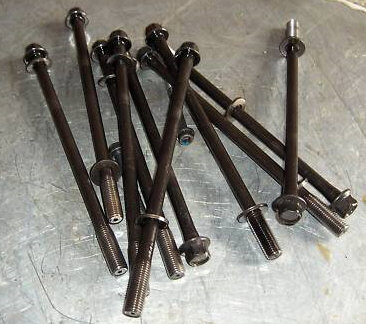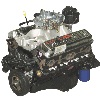
Home, Auto Repair Library, Auto Parts, Accessories, Tools, Manuals & Books, Car BLOG, Links, Index
Torque-To-Yield Cylinder Head Bolt
Installation & Removal Tips
by Larry Carley copyright AA1Car.com


Torque-to-Yield (TTY) head bolts are used on many late model engines to clamp the cylinder head to the block. They differ from ordinary head bolts in that TTY bolts are designed to stretch slightly when they are tightened down. TTY head bolts are often used with multi-layer steel head gaskets, so stretching the bolt helps even clamping forces across the head gasket to provide a better seal.
TTY head bolts also require somewhat less torque when they are tightened than a conventional head bolt. This helps reduce distortion in the cylinder bores. Rounder cylinder bores mean less blowby past the piston rings, lower emissions and better compression.
The metallurgy and heat treatment of TTY head bolts and regular head bolts is different, and you can sometimes tell one from the other by their appearance. A TTY bolt may have a narrower shank (so it can stretch more easily), and is often longer than a conventional head bolt. To be sure, refer to the vehicle manufacturer's service literature. Many parts stores can also look up your vehicle and tell you if it uses TTY head bolts or not.
TTY bolts may also be used on the engine's connecting rods and the crankshaft main bearing caps.
* Never reuse a torque-to-yield bolt. Because the bolts are designed to stretch once, stretching them a second time may stretch them beyond their yield point causing the bolt to break. They are one-time use bolts, so throw the old bolts away and buy new ones.
* TTY bolts are usually installed dry. Do not apply any oil, grease, assembly lube or sealer on the bolt threads. The reason why is because lubricants reduce friction when a bolt is tightened. This actually increases the torque load on the bolt, which may overload and stretch a TTY bolt too far, causing it to break.
* Always clean the bolt hole threads in the engine block before installing torque-to-yield head bolts. If there is any rust, corrosion or thread damage in the hole, it can increase friction and may cause inaccurate torque readings when the bolt is tightened. This can result in slightly loose bolts that may not seal the head gasket properly.
* On many aluminum cylinder heads, hardened steel washers are required under the head bolts. The washers help distribute the clamping load and prevent galling when the bolt is tightened down.
* If the cylinder head has been resurfaced to restore flatness, check to make sure the head bolts don't bottom out before they are fully tightened. You may have to use a copper or steel shim under the head gasket to restore proper head height so the bolts will tighten down properly. The gasket shim will also restore proper overhead cam timing, which can be affected when a cylinder head has been milled down.
* Use the procedure recommended by the vehicle manufacturer to tighten torque-to-yield head bolts, rod bolts and main bearing cap bolts. The tightening procedure always requires an accurate torque wrench and usually an angle gauge. The bolts are usually tightened down in three to five steps, applying a little more load on the bolts with each step. The final step is to twist each bolt a specified number of degrees to stretch the bolts to their design limit.
* If a bolt breaks when you are tightening it, you may have over-stretched it. Or, there may be debris in the bolt hole that is binding the bolt. Or, you may have mistakenly lubricated the bolt threads and overloaded the bolt. Or, the bolt may be bottoming out in the hold because it is too long, or because the head has been milled.
Because torque-to-yield cylinder head bolts are designed for one-time use, it's not unusual for them to break when you attempt to remove them. That's bad news because you then have to drill out what's left of the bolt from the hole in the block, and possibly repair the threads in the hole if they were damaged.
Rust and corrosion in high mileage engines can cause cylinder head bolts to stick, so to help loosen up the threads prior to removing them, try this trick:
* Place a punch in the center of each head bolt, then give each bolt a couple of raps with a hammer. The jarring action should help break loose any rust or corrosion between the threads on the bolts and those in the engine block. If a bolt still sticks, use the punch and hammer and rap it again. Or, if you have a pneumatic air hammer, use a blunt tip and hammer on the top of the bolt to shake it loose.
* After removing the torque-to-yield head bolts, inspect and clean the holes in the block. Buy a new set of replacement bolts, compare the length and threads to the original bolts to make sure they match, then discard the old bolts.
 Related Articles:
Related Articles: Click here for more Engine Related articles
Click here for more Engine Related articles Click Here to See More Carley Automotive Technical Articles
Click Here to See More Carley Automotive Technical Articles
